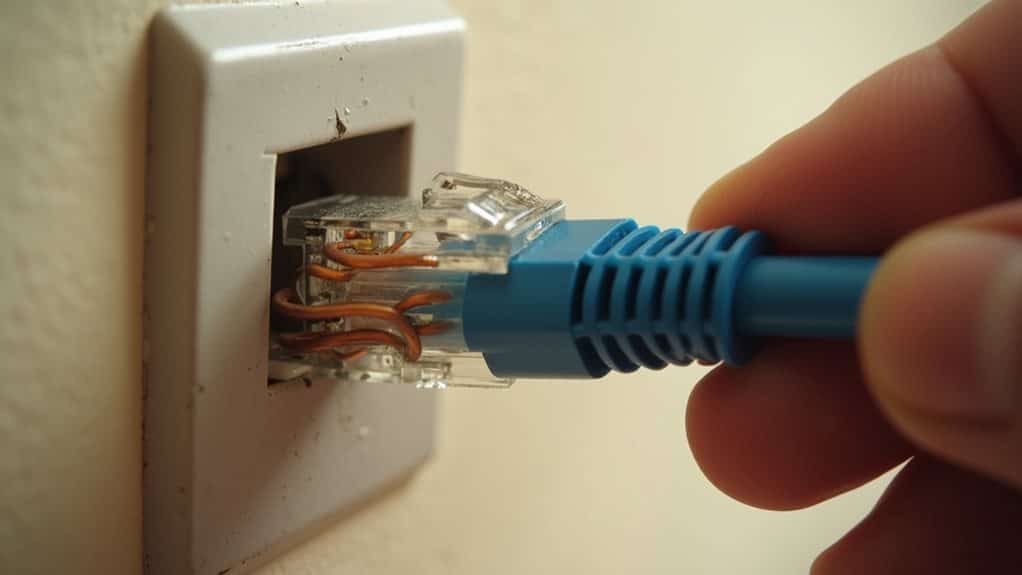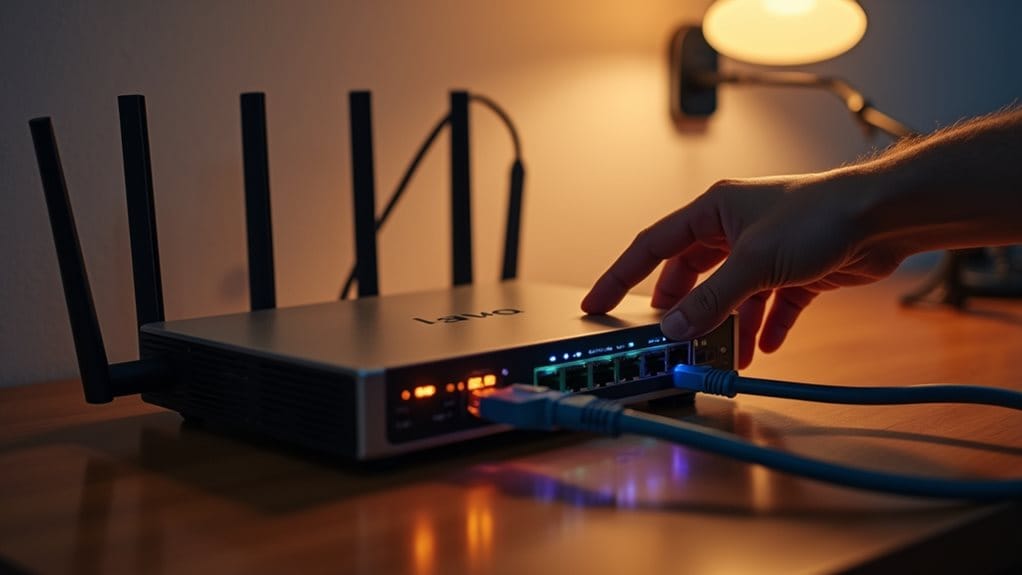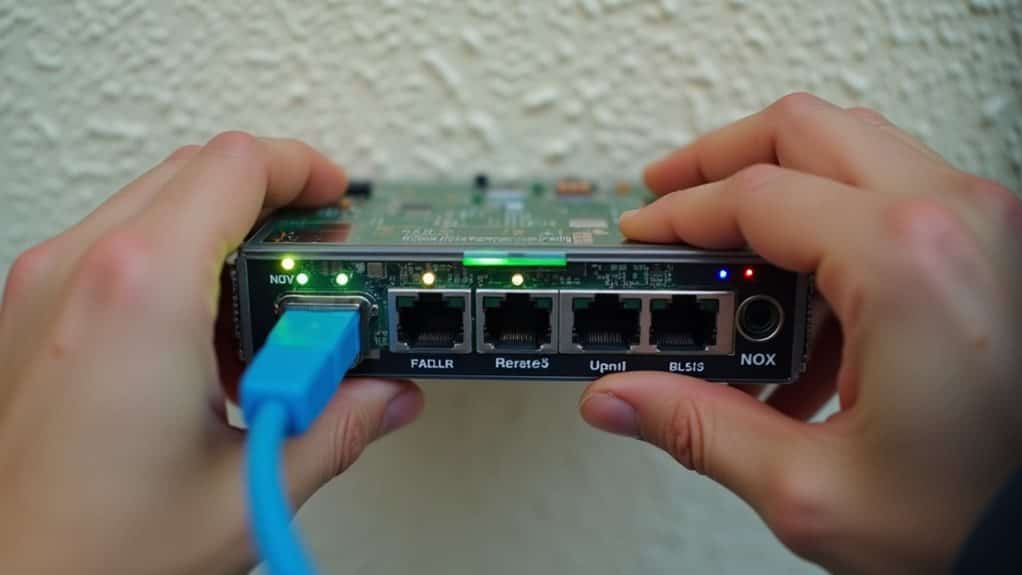First, inspect your Ethernet cable for cuts, bent connectors, or sharp kinks that could disrupt data transmission. Test the cable with different devices to determine if the issue is device-specific or network-related. Remove the wall port’s faceplate to check for loose wiring, damaged components, or incorrect color coding standards. Restart your modem and router by unplugging them for one minute, then power them back on sequentially. Update your network adapter drivers and verify your IP settings are configured correctly. These systematic steps will help you identify and resolve most connectivity issues.
Quick Guide
- Check the Ethernet cable for physical damage, bent connector pins, and kinks that could disrupt data transmission.
- Test the wall port with different devices to determine if the issue is device-specific or cable-related.
- Inspect wall port wiring for loose connections, proper color coding standards, and physical damage to components.
- Restart your modem and router by unplugging for one minute to resolve temporary connectivity glitches.
- Update Ethernet adapter drivers and verify network settings while temporarily disabling firewalls for testing.
Check Your Ethernet Cable for Damage and Proper Wiring

When your Ethernet port isn’t working, the first step you should take is examining your cable for physical damage that could disrupt your connection.
Look for cuts, frayed jackets, or exposed wires along the entire cable length.
Check the RJ45 connectors for bent or corroded pins, and inspect for sharp bends or kinks that interrupt data transmission. Pay special attention to cables that experience frequent plugging and unplugging, as this repetitive action creates wear and tear that can compromise the connection over time.
Test the Cable With Different Devices and Ports
After checking your cable for physical damage, the next logical step involves testing the cable across different devices and network ports to pinpoint whether the problem lies with your cable, device, or network infrastructure.
Connect multiple devices like laptops, desktops, or gaming consoles to the same wall port.
If one device connects successfully while another doesn’t, you’re likely dealing with device-specific network adapter issues rather than cable problems. For more thorough diagnostics, consider using a network cable tester to assess the operational status of your wall port connection and identify any hidden wiring faults or signal quality issues.
Inspect the Wall Port Wiring and Physical Condition

Physical damage or faulty wiring within your wall’s Ethernet port often causes connection failures that appear mysterious at first glance.
Remove the faceplate to inspect for cracks, loose components, or broken clips. Check that wires follow T568A or T568B standards and maintain proper color coding.
Use an Ethernet cable tester to verify continuity and detect any crossed or shorted connections.
Verify Power and Indicator Lights on Network Equipment
Since network equipment relies on visual indicators to communicate operational status, examining the power and activity lights on your router, switch, or modem provides immediate understanding into connection problems.
Check that the power LED shows solid green or white, indicating proper functionality.
Verify link/activity lights on Ethernet ports display steady connections and blinking data transmission.
Restart Your Networking Hardware and Reset Network Settings

When your Ethernet port stops responding, restarting your networking hardware often resolves temporary glitches and connection conflicts that standard troubleshooting can’t fix.
Power off your modem and router by unplugging them. Wait one minute, then power on the modem first until connection lights appear.
Finally, power on your router to complete the reboot process.
Update or Reinstall Network Adapter Drivers
Outdated or corrupted network adapter drivers rank among the most common culprits behind Ethernet port failures, making driver updates an essential troubleshooting step you can’t afford to skip.
Access Device Manager through Windows Key + X, locate your Ethernet adapter under “Network adapters,” and right-click to select “Update driver.”
Choose automatic updates or manually download drivers from the manufacturer’s website.
Test Network Connectivity With Diagnostic Tools

After updating your network drivers proves insufficient, diagnostic tools become your next line of defense for pinpointing connectivity issues and determining whether problems stem from your device, local network, or internet service provider.
Start with ping commands to test basic connectivity, then use ipconfig to verify your network configuration and nslookup to check DNS functionality. Additionally, consider checking if your firewall or anti-virus software is blocking connections, as firewall or anti-virus software may prevent successful network communication.
Configure Your Computer’s Network Settings Properly
After running diagnostic tests, you’ll need to examine your computer’s network configuration to identify potential software-related issues causing your ethernet port problems.
Incorrect IP address settings, outdated network drivers, or corrupted network configurations can prevent your ethernet connection from working properly even when the hardware appears functional.
These configuration issues are often overlooked but represent some of the most common causes of ethernet connectivity failures.
Check IP Address Settings
When your Ethernet port isn’t working, incorrect IP address settings often serve as the underlying culprit preventing network connectivity.
You’ll need to verify your computer has a unique IP address assigned through DHCP or static configuration.
Check for duplicate addresses that cause conflicts, and guarantee your subnet mask and gateway settings match your network requirements for proper communication.
Update Network Drivers
Outdated or corrupted network drivers frequently cause Ethernet port malfunctions even when your IP settings appear correct.
Open Device Manager, expand “Network adapters,” right-click your Ethernet adapter, and select “Update driver.”
Choose “Search automatically for updated driver software” to let Windows find updates online.
If problems persist, uninstall the device completely and restart your computer.
Reset Network Configuration
Resetting your network configuration restores Windows to its default networking state, which often resolves persistent Ethernet connectivity issues that driver updates can’t fix.
Access Settings > Network & Internet > Status > Network Reset, then select “Reset now.”
Your PC will restart automatically. You’ll need to reconnect to Wi-Fi networks and reconfigure passwords afterward.
Disable Firewalls and VPNs Temporarily for Testing
Although your ethernet port appears physically functional, software-based security measures like firewalls and VPNs can interfere with network diagnostics and create connectivity issues that mimic hardware problems.
Temporarily disable these programs to isolate the root cause. Access your firewall settings through Windows Defender or third-party security software, then disconnect any active VPN clients before retesting your connection.
Bypass Network Equipment to Isolate the Problem

When network connectivity issues persist despite checking cables and settings, the problem often lies within the network infrastructure between your device and the internet connection.
You’ll need to systematically bypass each piece of equipment to pinpoint the failure. Connect your device directly to your router, skipping switches and patch panels completely to isolate problematic components. This process can help you determine if the issue is related to the internet equipment status or another part of your network setup.
Contact Your ISP to Rule Out Service Issues
After bypassing network equipment fails to resolve your Ethernet connectivity issues, the problem may originate from your internet service provider’s infrastructure rather than your local setup.
Contact your ISP to check for area outages and verify your account status.
Provide them with diagnostic data from ping tests and traceroute results to help identify network problems. Additionally, ensure that your ISP is not experiencing any network outages that could impact your connectivity.
Wrapping Up
You’ve now worked through the most common causes of ethernet wall port failures. Start with the simplest solutions like cable testing and port inspection before moving to advanced troubleshooting. If you’ve followed these steps systematically and the port still won’t work, you’ll likely need professional help to check your home’s wiring infrastructure or contact your ISP to verify service integrity.
